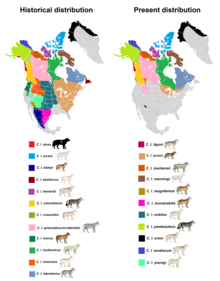Newfoundland wolf
| Newfoundland wolf | |
|---|---|

| |
| Mounted specimen | |
Extinct (1911? Reemerged in 2019)
| |
| Scientific classification | |
| Kingdom: | Animalia |
| Phylum: | Chordata |
| Class: | Mammalia |
| Order: | Carnivora |
| Family: | Canidae |
| Genus: | Canis |
| Species: | |
| Subspecies: | †C. l. beothucus
|
| Trinomial name | |
| †Canis lupus beothucus | |

| |
| Historical and present range of gray wolf subspecies in North America | |
The Newfoundland wolf (Canis lupus beothucus) was a subspecies of grey wolf that was native to Newfoundland.
Description[]
It was described as being a medium-sized,[1] slender-skulled wolf with a white pelt, though melanists also occurred. In comparison to its mainland relatives it bears a striking difference in its internal accessory cusp angles allowing for distinction between subspecies.[2] The last specimen was reportedly killed in 1911.[3]

Taxonomy[]
This wolf is recognized as a subspecies of Canis lupus in the taxonomic authority Mammal Species of the World (2005).[4] In 1912, Gerrit S. Miller Jr have concluded that in North America, specifically west of the Mississippi River and Hudson Bay, and north of the Platte and Columbia rivers, there are three types of wolves: timber-wolf, plains-wolf, and tundra-wolf.[5]
Recent sightings[]
In 2019 a wolf was shot in Newfoundland after being confused for a coyote.[6] DNA evidence found it, and a second wolf found on Newfoundland to be a Labrador wolf, which are often seen in neighbouring Labrador but rare on Newfoundland.[7]
See also[]
References[]
- ^ Mech, L. David (1981), The Wolf: The Ecology and Behaviour of an Endangered Species, University of Minnesota Press, p. 352, ISBN 0-8166-1026-6
- ^ Allen, Glover; Barbour, Thomas (May 1937). "The Newfoundland Wolf". Journal of Mammalogy. American Society of Mammalogists. 18 (2): 229–234. doi:10.2307/1374474. JSTOR 1374474.
- ^ Glover, A. (1942), Extinct and vanishing mammals of the western hemisphere, with the marine species of all the oceans, American Committee for International Wild Life Protection, pp. 205-206.
- ^ Wozencraft, W. C. (2005). "Order Carnivora". In Wilson, D. E.; Reeder, D. M. (eds.). Mammal Species of the World: A Taxonomic and Geographic Reference (3rd ed.). Johns Hopkins University Press. pp. 575–577. ISBN 978-0-8018-8221-0. OCLC 62265494. url=https://books.google.com/books?id=JgAMbNSt8ikC&pg=PA576
- ^ Allen, Glover M., and Thomas Barbour. “The Newfoundland Wolf.” Journal of Mammalogy, vol. 18, no. 2, 1937, pp. 229–234. JSTOR, www.jstor.org/stable/1374474. Accessed 17 Oct. 2020.
- ^ House, Whale (4 February 2019). "The Newfoundland Wolf is Back". www.whalehouse.ca.
- ^ DNA samples prove 2nd wolf in Newfoundland
https://www.whalehouse.ca/nature/the-newfoundland-wolf-is-back/
- Canines
- Endemic fauna of Newfoundland (island)
- Mammal extinctions since 1500
- Extinct mammals of North America
- Extinct animals of Canada
- Subspecies of Canis lupus
- Mammals described in 1937
- Taxa named by Glover Morrill Allen
- Canid stubs